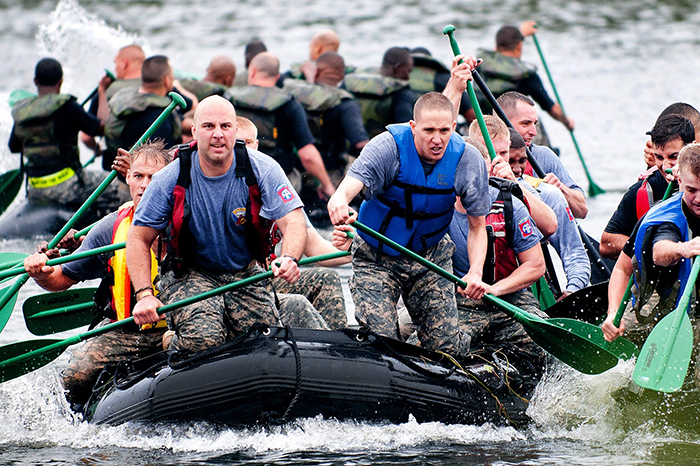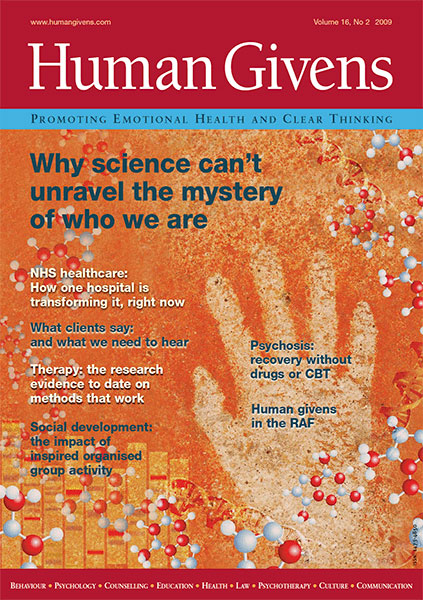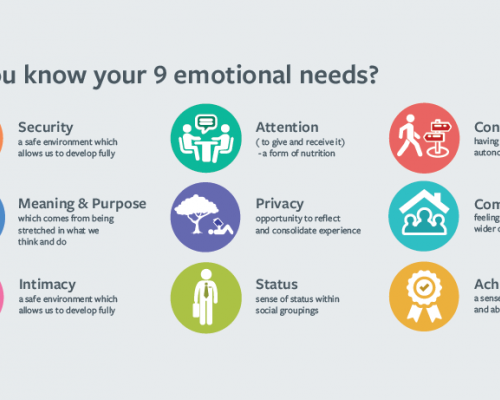A life in service
Andrew Jones describes how the human givens approach has transformed his effectiveness in his demanding role as a chaplain in the Royal Air Force.
I had spent six enjoyable years as a parish priest in Wales before deciding to join the Royal Air Force (RAF), thinking its lifestyle would be better suited to my personality. (In the parish on Sunday evenings we would have evening prayer, followed by a t'ai chi class, followed by a kung fu class, and I led all of them.) However, immediately on joining the RAF, it was clear that its pastoral demands would be far more intense than those of the parish.
There are 23 major RAF bases in the UK (some in remote places, many the equivalent of small, self-contained towns), as well as 5,000 servicemen and women deployed around the world. At the military base where I am currently stationed, serving personnel are abroad for six to seven months and then return to the UK for just under a year – a fair amount of which time is still spent away from their homes, on training courses or exercises. Just the sheer amount of separation causes huge stress on families and relationships, augmented, of course, by the anxiety experienced by those going to dangerous places, or those waiting for their return. Fairly frequently, personnel return with difficulties resulting from horrible experiences – sometimes full-blown post-traumatic stress disorder or else hypervigilance and a degree of anxiety that they didn’t have before they went. We also have youngsters as young as 16 coming into training, away from home for the first time in very demanding circumstances. They may have to cope with considerable homesickness, big decisions about their futures, difficulties coping with the course and all the ensuing anxiety.
People don’t have to seek help from chaplains – there are medical and welfare officers, personnel people and social workers that they can also approach for help. But we are the ones who are most closely associated with people in uniform. We go where they go. We, too, get deployed to dangerous places. In the military, the chaplain is everybody’s friend and helper.
However, at the outset, I didn’t feel qualified to deal with a lot of what people were asking of me. During my ministerial training I did a diploma in pastoral studies, which covered some basic listening skills, the human life cycle and a bit of sociology and psychology. We were also introduced to the Myers-Briggs Personality Type Indicator. However, now people were asking me if I could offer marriage guidance counselling or anger management. Some people approaching me for help were clearly deeply depressed. If I didn’t feel equipped to help someone, all I could do was refer to a doctor or the social worker or to Relate counsellors and it came to a point where I found this rather unsatisfactory. So I asked the advice of the chaplain in charge of training at the time, Bill Mounsey, now retired. On his advice, as I was then based in Scotland, I took a course with COSCA (the professional body for counselling and psychotherapy in Scotland), which provided me with a certificate in counselling skills. This gave me an introduction to the main counselling traditions but majored heavily on the person-centred approach and active listening skills. Back in my air force pastoral role, trying to put these into practice, I quickly became frustrated. We had been taught not to give people advice but to listen, reflect back and allow them to come to their own conclusions. However well I seemed to practise this, there was always an unsatisfactory result. People left feeling that they hadn’t been helped; they wanted answers. For my part, I could often see the answers I needed to give but, as a result of the training, held back.
Not just a theory
Still feeling that I had more to learn, I consulted Bill Mounsey again and, by that time, he had discovered Human Givens College and was well into his studies for the Human Givens Diploma. On his advice, I went along to a Human Givens seminar, on anger management. This was so different from my previous studies. It was practical and prescriptive, providing information and techniques that we could give and practise with our clients. It offered so much more than listening skills and it was clear that the information was rooted in fact – such as how emotional arousal occurs, why it may escalate and how to bring it down. For once we weren’t just talking about theories or models. By this time I was part of a chaplaincy team in a very big and busy air force base and, by sheer coincidence, the day after the seminar, someone walked through the door asking for anger management. I decided to go for it.

Vince said that he was arguing with his wife and flying off the handle so often that his wife had more or less insisted that he seek help. He was fearful that his marriage was on the line. I told him what I had learned from the seminar about why we get angry – that it is an ancient and necessary survival mechanism but sometimes gets out of hand when important needs are not being met. There didn’t seem to be any deeper problems with the relationship, so I taught him the ABC technique I had learned the previous day – awareness (of negative, hostile thoughts), blocking and challenging (to which I now normally add a D – distraction). I also taught him how to calm himself down with 7/11 breathing. We also talked about how he and his wife communicated with each other and the necessity of taking a ‘time out’ if emotions started to escalate.
The session lasted about an hour and then I didn’t see him again for months. He didn’t call me back, didn’t let me know what he was doing, didn’t make a follow-up appointment. Eventually, I just happened to bump into him in the gym and asked him how he was doing. He looked surprised. “Oh great, thanks,” he said. “I’ve had no problem at all since seeing you.” I felt extremely pleased to know that a single day’s training had led to instant success. This confirmed me in my feeling that working towards the Human Givens Diploma would be the right path for me.
Fear of a subordinate
I was soon to be truly tested, however, when Barbara, a relatively senior medical officer came to me for help. She had developed a phobic reaction to one of her subordinates, a younger man who was quite a forceful, intimidating character. She had had to give him a bad report and he had reacted so badly to it that she had developed a fear of him. She was a single, highly career-oriented woman, who had been used to staying and working late in the office but had become afraid to do so, in case he was waiting to attack her in the car park (although there was no evidence that he would even consider doing so). She was constantly worried that she might see him, would go to pieces at the prospect of having to speak to him, and, whenever she did come across him, which was fairly often in the small building they both worked in, she experienced a panic attack. Her colleagues and her boss had all noticed the massive change in Barbara and she was so distraught that she was thinking of leaving the service. For a single, long-serving career woman for whom the RAF was her life, that was quite a severe reaction.
Barbara told me that she was about to go to a conference to deliver a presentation. The man she feared would be in the audience and, even though the conference hall was large, she felt she would panic if he were there and she wouldn’t be able to give her presentation. This was a terribly humiliating prospect to her and it was obvious that she needed the rewind technique. Although I had by that time had training in relaxation and guided imagery, I hadn’t yet trained in the rewind technique for dealing with phobias and post-traumatic stress. I had, however, read a full description of the technique1 and, because the circumstance was so desperate, I immediately decided to give it a shot.
“That’s rubbish!”
I put on a persona of total confidence as I told Barbara about the technique and the theory behind it. Immediately she snapped, “I don’t believe in that sort of rubbish! I’m an expert in brain trauma and that is not going to work.” I hadn’t known her speciality and was somewhat thrown off my stride but I decided to persevere. “You haven’t got to believe in it,” I told her firmly. “You just have to try it. What have you got to lose?” She could hardly disagree and so we went ahead. At the end, she opened her eyes and said sharply, “Nothing happened”. I suggested that she give it no further thought, go back to work and call me to let me know how she was doing. I heard from her much more quickly than I had expected. She had left my office, walked back to her own, which was just five minutes away, bumped into the man she had feared in the corridor and had no reaction to him whatsoever. It was a dramatic result from someone who had been so cynical. Barbara, of course, tried to explain the outcome differently, saying it must have been because I gave her ‘permission’ not to react and so on. But all her workmates were soon commenting on how relaxed she seemed and she gave her presentation without any problem at all. Whatever her remaining reservations about the rewind technique, from that day on she became my biggest fan!
Having since undergone the proper training, I have had cause to use the rewind technique very many times – and many a time it may have been what saved the careers, and sanity, of those who have suffered terrifying or horrifying experiences in the theatre of war.
It’s not like ‘therapy’
The human givens approach is ideal for the military context because we mostly see people just once or twice. People drop in on us when they can – we are chaplains, not counsellors, so it is all very casual – and it is excellent to have a set of tools that enable us to make a difference very quickly. Also, because it is solid fact that informs the human givens approach, what we do doesn’t have to seem like ‘therapy’ – the connotations of which don’t suit the image that many service personnel have of themselves. I also think that giving information instead of ‘therapy’ returns control to the people in front of me, in that they can take what they learn and put it into use for themselves.

For instance, I see many young lads on initial training, who are struggling with the course, getting anxious, and finding it difficult to make friends. Perhaps they have dreamed for years of being in the military, watching Top Gun and playing combat games on their Xbox or PlayStation, and have developed all sorts of ideas about themselves and how they would cope. And then they find that they can’t cope. The last thing such lads need is someone suggesting that they are candidates for therapy. So I normalise their circumstances and say, “Well, everybody struggles at some point – that’s a normal consequence of being on the course. But I can teach you some techniques that will help you handle it and get on.” I sell these as ‘warrior skills’. My usual pitch is, “You think you’ve got stress in your life. Think about the samurai. They were fighting up close with blades, and then they would go home, do calligraphy and have tea ceremonies! They had to be able to endure enormous stress, so they had to develop techniques to calm themselves down and cope. We have honed and refined some of those techniques and I can teach them to you today. Would you like that?” They are usually delighted. I teach them about emotional arousal and 7/11 breathing, do guided imagery with them and encourage them to practise it, to hone their skills.
I make a point of telling them that the 7/11 breathing can even help them to shoot straight, explaining that hands shake after running to get into a firing position, because of the adrenalin coursing through the body, but the deep breathing calms that down. That allows them to view 7/11 breathing as an add-on to their practical skills, rather than as an anxiety-control mechanism. They often go on to teach it to their friends.
Avoiding World War Three
Relationships conducted within a military setting may be particularly fragile, with the stress of long separations and the anxiety associated with the work causing high emotional arousal. Wendy and Blake’s problems were fairly typical. They were arguing all the time. Wendy accused Blake of hitting her; Blake said she had gone for him with a knife first. Clearly, their relationship had degenerated to a dangerous level and Blake had moved out into ‘the block’, the accommodation provided for single service personnel. But they agreed to see me, first separately and then together, to see if they could get back on track. Otherwise, Wendy was planning to move away (she was not in the service), with their two children. A lot was at stake.
From talking to them separately, it was clear that they were quite immature as a couple. They had met when in their teens. Blake was an ‘extreme male brain’, found communication very difficult, didn’t like talking about his feelings and was very shy. Wendy was the absolute opposite, couldn't stop talking and almost literally tried to force Blake to give more than he could. Individually, I gave them some information on the differences between male and female communication styles and reasonable expectations. I pointed out that intimacy doesn’t have to come just from one person and that close conversations with friends of the same sex can often provide nourishment of a different kind. They both accepted this keenly, as it was new information to them.
Then I brought them together. Of course, as they had problems at the forefront of their minds, the process of selective recall would ensure that that was all they would think of when they saw each other. So, as soon as they arrived, to avoid World War Three starting in my office, I said that we were going to start by doing something a little bit different. I had not done guided imagery with either of them before this point but, before I had even asked them how they were, I proceeded to relax them. Then, in guided imagery, I asked them to remember a time when they were really happy together. Through my reconnecting them with positive memories from when they were in love and reminding them that they were here because they still loved each other, their selective recall now directed them to look for all that was good. When we finished the guided imagery, both were deeply calm and relaxed and we had a positive, productive session. We went over what we had talked about separately and they decided that they had plenty to work on. They were very happy when they left, intending to re-plan a life together.
Needs and resources
I incorporate the human givens idea of essential needs and resources in whatever way it seems appropriate for the people I’m working with. For instance, in the ‘beliefs and values’ programme that chaplains deliver to new trainees, I always talk about homesickness. Nearly everyone experiences homesickness to some degree at first, although some won’t admit it. I discuss it in terms of evolutionary biology, explaining that the brain is a survival organ, which grew in size to make us more flexible. It wants to know its environment so that it can feel safe. It wants to know who its friends are, where it can fit into groups, where it can find food and shelter and that it can be sure to cope with the demands being placed on it. At home, all that was known; it had sussed out the environment. But now, in a new environment, the brain is not as happy. I tell the trainees that, while they are going through the process of adaptation, what their brains want to do is get back to where they feel safe. The discomfort they feel as a result is what we call homesickness. “The way to overcome it,” I explain, “is to put your energies into becoming competent where you are now, into making friends and getting good at the course, etc. The in-between bit, while this is happening, is quite normal but the more you throw yourself into the course and enjoy being where you are, the quicker your homesickness will disappear.” So, without actually mentioning needs and resources, I tell them about the importance of getting their needs met.
Understanding how the brain works, through the human givens approach, has also given me extra courage as a counsellor. An engineer called Richard turned up one day, told me his wife had left him and then said, “I’ve come to see you because I’m afraid I’m going to kill myself”. To check out how serious he was, I asked him if he had thought about how he was going to do it. “I’m going to throw myself under a train,” he replied at once. “Where?” I asked. He specified the local unmanned level crossing. “When are you thinking of doing this?” “I’ve got a train timetable at home,” he said.
Like looking through the lens of a gas mask
CONNIE worked as a supplier, which involves the moving, storing and stock control of large amounts of equipment. She had plenty of experience behind her and was looking forward to promotion. Every year, everyone in the service has to re-qualify in what we call common core skills, which includes first aid, weapons handling and drills associated with respirators (gas masks). Connie had done the common core skills course many times. But on the last occasion recently, she had had a screaming fit and vomited as soon as she put on her respirator. She was sent to me – because, by that time, it was getting around that I could deal with things like this.
It turned out that, on her recent deployment to Afghanistan, Connie had been in the back of an armoured personnel carrier that had come under fire – an event which had traumatised her. But, as I continued to talk to her, it emerged that she was claustrophobic even before she went to Afghanistan. On her last birthday, as a joke, her colleagues in supplies had taped her into a large box and sent her through the supply chain. She had been claustrophobic ever since that terrifying experience. To rub salt into the wound, her navy husband worked on a submarine, so visiting him was becoming very difficult for her, which didn’t bode well for the relationship. By the time I saw her, she was struggling with small spaces and enclosure of any kind, to the point that just putting a respirator on her face had caused a panic attack.
Clearly, it was another case for the rewind technique. When I asked where she would like to go to relax, the immediate scenario that came to mind was a Saturday morning, when she had a lie-in, and her kids would come into her bed and cuddle up with her under the duvet. That, she said, was where she felt safe and secure. After doing the rewind, on the spur of the moment, I had her ‘walk’ to the bedroom window. “I want you to take a look out of your bedroom window,” I said. “And it is just like looking out through the lens of your respirator. And just as you feel safe and secure in your bedroom, and you can look out on the world and feel protected from it, so it is the same when you put on your respirator and look out through it. You can feel just like you do now, looking out of your bedroom window.” She did the common core skills course again a couple of days later, passed easily and even assisted other people with their respirator drills.
Suicide risk
My heart sank. This was clearly quite serious intent. I knew that some colleagues might have insisted, with that degree of risk, on getting him compulsorily detained in a psychiatric hospital. But, if I did that, the prognosis for his future in the service would be pretty grim. I decided that, as Richard was an extremely ‘left-brained’, practical person, I would make use of his left-brained tendencies and explain to him how the brain worked. “Would you like to know why you want to kill yourself?” I asked. I explained how his high emotional arousal was swamping his ability to think straight and so he was thrown back on the thinking style of his emotional brain. In this thinking style, I told him, there were no in-betweens or nuances: either life was great or it was unbearable. Life clearly wasn’t great, so his emotional brain had decided he had to kill himself. I went into great detail, so that his engineer’s brain could grasp the ‘mechanics’, which it did. Now he was hooked. Rapport had been established in a way that was natural for him.
I gave him specific techniques for getting his thinking brain back in control and he agreed to use them. Then I reinforced all this with guided imagery and asked where he would like to go to relax. He chose the desert; he had been deployed there and loved the lovely, quiet nights and the clear, star-filled sky. I relaxed him deeply and reminded him that he was still young and good looking, had a good job and good prospects; that his marriage had been an important and very meaningful part of his life but was only one aspect of it and that most of the other aspects of his life were working well; that his future looked promising, despite current problems. We rehearsed a worthwhile future for him to look forward to and then, because he was already in the desert, I told him the beautiful story of the desert sands, against which a river, thwarted on its way to the sea, ends up dashing itself in despair – until it hears the voice of the wise old desert sands. Let go, they say, let go and allow yourself to be absorbed into the wind and carried over the desert until, at the top of a far mountain, you will fall as rain and, renewed, become a river once more. It is a powerful story, which offers a clear metaphor for handling depression and despair.
I asked Richard to come back and see me in a day or two, as I knew I had taken a risk and wanted to keep tabs on him. He came back two days later and said, “I’ve been doing what you told me and I’m completely okay. And the thing that really got me was that story.” That taught me that even an extremely left-brained man could respond deeply to a metaphor directed at his right brain. I have come across him since and know he has stayed well.
The production line
Pastoral work makes up the majority of a service chaplain’s role but we are also involved at many other levels where, I have found, the human givens can usefully inform what we do. For instance, we are asked to give briefs on all sorts of things. Stress management is high on the military agenda at the moment and it is useful if we can contribute to that. Regular training is also held for casualty-notifying officers – those who may have to break bad news to relatives – and for visiting officers who have to support families after a bereavement or serious injury. Chaplains also have an important part to play in troop decompression. This means helping troops returning from operational duties to adapt successfully back to home life.

Chaplains can be involved in teaching at every level of personnel welfare. Sometimes we are in a position to comment on practices in the workplace – a useful position to be in, if a reorganisation is planned and is not in accord with sound principles of human flourishing. I had my first taste of this some years ago, when the engineering section was being reorganised but without any input sought from the engineers who did the job. Their work was being turned into an industrial process, with much of the human contact removed from it, and it clearly wasn’t going to work. Before, each squadron had its own engineering backup; pilots would relate directly to engineers; engineers would see the airframe they were working on through to the mission, and then the flight crew would report back afterwards, so that engineers had a sense of ownership of the whole process. Now, in effect, there would be a production line, where engineers had no attachment to any squadron, worked on any aircraft and had no means of receiving personal feedback on what they had done. At a meeting at which this new procedure was being discussed, I was standing in for a more senior chaplain. I had been given strict instructions to stay quiet, so I did – until the senior commanding officer, whose idea it all was, came over to me and said, “You know how people feel about things. What do you think of this idea?” “I think it is dreadful,” I said. “It isn’t going to work.” He was shocked and quite angry, and we had quite a heated argument. Indeed, afterwards, the joke was that my career was on the line.
But then the next edition of Human Givens journal came out and in it was an article about the causes of stress in organisations.2 It included a checklist of the 25 major organisational stressors – and our proposed plan included a considerable number of them. Against the advice of my senior, I photocopied the article and sent it to the senior commanding officer, who clearly read it and wrote an appreciative letter back to me – and the whole plan was reversed. I am not saying that occurred purely because of my intervention – I imagine others must also have given negative feedback – but I do think it helped that the supporting evidence came from a professional journal, quoting the findings of objective studies.
Not ‘them’ and ‘us’
The human givens approach is put to use at all sorts of levels in our military setting. It can be used to explain the most effective ways to learn, for instance. Lots of people in our very pressured environment are extremely tense and anxious, and, as we know, no one can learn unless they are calm. It can also help to change perspectives in a powerful way. In the beliefs and values programme that I teach, I touch on the roots of terrorism and make sure to explain that, in environments where people’s basic needs are not being met, people get especially highly emotionally aroused, leading them to think with a more primitive part of their brain and come to extreme conclusions. Hearing this helps personnel consider a very different perspective on terrorism from the more familiar ‘them’ and ‘us’ and ideas of evil.
The human givens has so transformed my work that I’m currently taking the lead in trying to bring more human givens training to chaplains (there are about 65 of us across the RAF). Four or five of us are already diploma graduates and my goal is for all new-entrant chaplains to be introduced to basic human givens ideas. Knowledge of the human sciences provides us with a much greater clarity of vision and a bigger tool-box of techniques with which to assist those who, in our pastoral ministry, come to us for any sort of help.
Andrew Jones, who holds the Human Givens Diploma, has been a chaplain in the Royal Air Force for the past 13 years. Prior to that he was curate in the parish of Caerphilly in south Wales for six years. He studied religious studies at the University of Lancaster and did his ministerial training at St Michael and All Angels College at Llandaff. His particular interest is in spirituality and mysticism. He lives with his wife and two daughters.
This article first appeared in "Human Givens Journal" Volume 16 - No. 2: 2009
 Spread the word – each issue of the Journal is jam-packed with thought-provoking articles, interviews, case histories, news, research findings, book reviews and more. The journal takes no advertising at all, in order to maintain its editorial independence.
Spread the word – each issue of the Journal is jam-packed with thought-provoking articles, interviews, case histories, news, research findings, book reviews and more. The journal takes no advertising at all, in order to maintain its editorial independence.
To survive, however, it needs new readers and subscribers – if you find the articles, case histories and interviews on this website helpful, and would like to support the human givens approach – please take out a subscription or buy a back issue today.
References
- Griffin, J and Tyrrell, I (2003). Human Givens: a new approach to emotional health and clear thinking. HG Publishing, East Sussex.
- Old, J (2005). Managing with human nature. Human Givens, 12, 3, 34–7.
Latest Tweets:
Tweets by humangivensLatest News:
HG practitioner participates in global congress
HG practitioner Felicity Jaffrey, who lives and works in Egypt, received the extraordinary honour of being invited to speak at Egypt’s hugely prestigious Global Congress on Population, Health and Human Development (PHDC24) in Cairo in October.
SCoPEd - latest update
The six SCoPEd partners have published their latest update on the important work currently underway with regards to the SCoPEd framework implementation, governance and impact assessment.
Date posted: 14/02/2024















